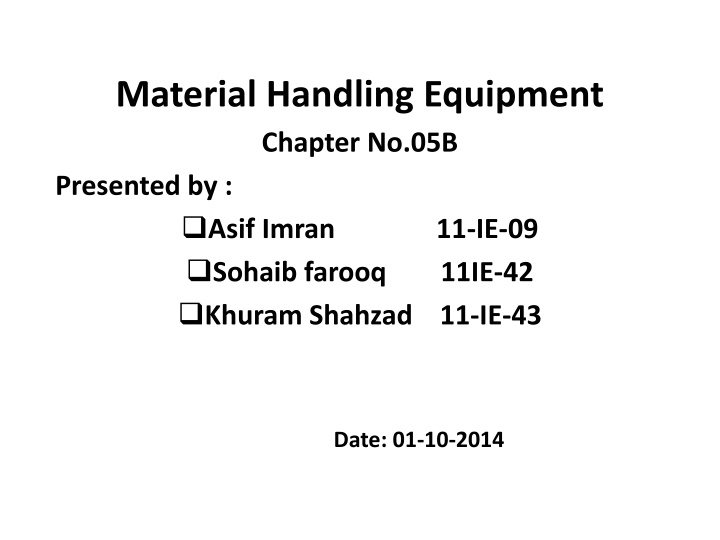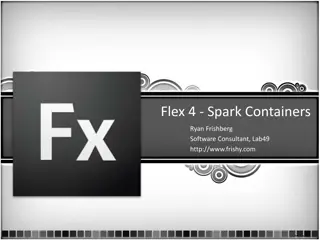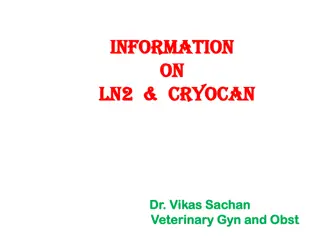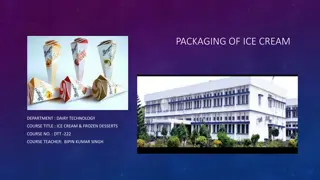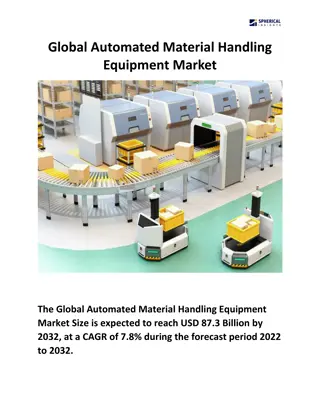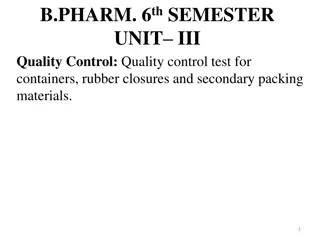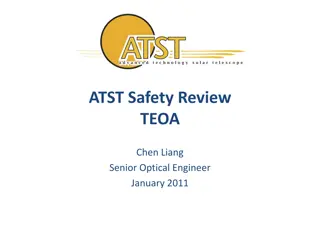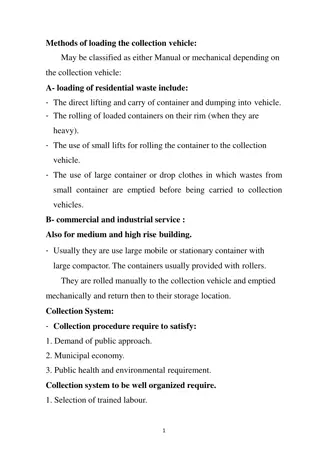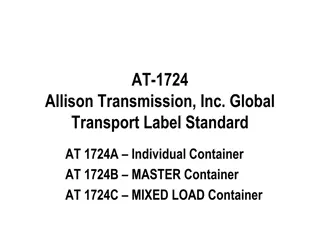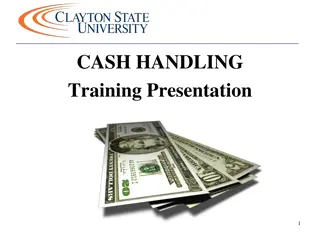Overview of Material Handling Equipment and Containers
This chapter covers various types of containers used for the movement and storage of loose items, including pallets, skid boxes, and tote pans. It explains the significance of unitizing devices like pallets and unitizers in optimizing load efficiency. Additionally, the role of unitizers in assembling products into layers and shrink-wrapping, strapping, and banding equipment for unitizing loads is discussed. The content also highlights the importance of palletizers and container pallet containers in industrial applications.
Download Presentation

Please find below an Image/Link to download the presentation.
The content on the website is provided AS IS for your information and personal use only. It may not be sold, licensed, or shared on other websites without obtaining consent from the author.If you encounter any issues during the download, it is possible that the publisher has removed the file from their server.
You are allowed to download the files provided on this website for personal or commercial use, subject to the condition that they are used lawfully. All files are the property of their respective owners.
The content on the website is provided AS IS for your information and personal use only. It may not be sold, licensed, or shared on other websites without obtaining consent from the author.
E N D
Presentation Transcript
Material Handling Equipment Chapter No.05B Presented by : Asif Imran 11-IE-09 Sohaib farooq 11IE-42 Khuram Shahzad 11-IE-43 Date: 01-10-2014
Containers To facilitate the movement and storage of loose items. Containers contain skid and skid boxes, pallets and Tote pans. Loose items are often placed on the tote pans or in the skid boxes. For standard cargo container choice of pallet and unitizer effect the load efficiency.
Containers Pallets: Pallets are the most common unitizing device. Skids and skid boxes: Mostly used in manufacturing. Generally made of metal ,quite rigid and well suited for unitizing wide variety of items. Generally too heavy to be lifted manually.
Containers Tote Pans: Used to unitize the loose item. When tote pan is empty should nest or collapse to insure high space utilization. Tote pan dimensions should coordinates with case and pallet dimension to insure high utilization of material handling vehicles.
Unitizer Unitizers: A machine that assembles products in a predetermined pattern to form layers and sequentially deposits the layers on a slip sheet. To unitize the load a load special equipment has been designed to facilitate the formation unit load. Strechrap: is a highly stretchable plastic film that is wrapped around items
Unitizer Shrinkwrape,strechwrp,straping and banding equipment is used to unitize a load. shrink-wrap strapping Strapping can be perform by using plastic, fiber material. Shrink rapping is similar to blister packing process and used for small articles. Strechwrapping is plastic film tightly around a load. Multiple layers are used to avoid from weather.
Unitizer Palletizer: Receive the product and place them on a pallet according to prescribed pattern. Depettelizer used to remove material from the pallet. Used in bottle and cement industry.
Container Pallet container: These pallets are loaded into the truck. These pallets are designed according to the standard size of cargo.
Material Transportation Equipment Material conveyor,vehicle,monorails,hoists and cranes. How to distinguish from each other: Degree of automation(walking , riding , and automated) Flow pattern(continous,intermitent,synchronous asynchronous) Location (underground, in floor , floor level ,over head) Throughput capacity. transportation equipment consist of vs.
Conveyor Conveyor used to move material between specific points. They are used to move material over a fixed path. Sufficient volume is required for movement depends upon the material to be handled and move to be performed.
conveyor Chute conveyor: Chute conveyor is one of the most inexpensive conveyor. Often used to link two powered conveyor lines. Used to provide accumulation in shipping areas. Used to convey items with minimum space required. Sometimes jams and blockages occur.
Belt conveyor A conveyor belt (or belt conveyor) consists of two or more pulleys, with a continuous loop of material Flat Belt Conveyor: Falt belt conveyor generally used to the medium and light weight material. Because of friction between the load and belt load conveyor provide considerable orientation and placement of load
Telescoping Belt conveyor It is a flat belt conveyor that operates on telescoping slider bed. Mostly used in receiving and shipping docks where conveyor is extended inbound and outbound trailers for loading and unloading.
Magnetic Belt conveyor Magnetic conveyor consist of steel belt or magnetic slider bed or magnetic pulley. It is used to transport ferrous material vertically , upside down, and around corners as well as for separation.
Roller conveyor Roller conveyors are both power driven and non power driven. Non power driven is refferd to as a gravity conveyor . Motion in non power driven is achieve by inclination In line shaft conveyor rollers are connected to the drive shaft by elastomeric belt. A drive roller is connected to belt driven roller called zone Zone can be programmed to turn on if they detected the load. So electricity can be saved.
Wheel conveyor Wheel conveyor are similar to the roller conveyor in design and function. A sries of stake wheel are mounted on a shaft. Spacing of wheel is load being transport. Wheel conveyor are economically more better than roller conveyor. Use for light duty applications.
Slat conveyor Slat conveyor consist of discretely slats connected to a chain. Similar to the belt conveyor. Orientation and placement of load is controlled. Heavy load with abrasive surface that can damage the belt can be transported through this.
Chain conveyor Chain conveyor consist of one or more endless chains on which load are carried directly. The chain is located at the bottom and pull material through the trough. Use to transport the pallets of bulk material.
Towline conveyor The Towline conveyor is used to provide power to wheeled carriers such as truck, dollies or carts. The towline the be located overhead, flush with the floor or in the floor. Used for long distance and high frequency.
Trolley conveyor The trolley consist of series of trollies supported from or within an overhead track. Equally spaced and used to carry multiple units of product.
Power and free conveyor The overhead power and free conveyor are similar to the trolley conveyor. It utilize two tracks powered and non powered or free. Carrier are suspended from set of trolleies that run on free track. Linkage between power chain and trollies is achieved using dogs. Dog through extension push the carrier on the free track. Advantage of of this is to carrier can be engage and disengage.
Cart on track conveyor Used to transport along a track. Employing the principle of a screw cart is transported by a rotating tube. The basic element of the conveyor are rotating tube ,track and cart. The cart are independently controlled to allow multiple cart to be located on the tube.
Conveyor sortation Devices A sortation device is used to assemble material(cases ,items,totes,garments) with a similar characteristic by correctly identifying the similar merchandise and transporting it to the same location.
Deflector Deflector is a stationary or moveable arm that deflects product flow across a belt or roller conveyor to design location. Deflector is necessarily position before the item to be sorted. Stationary arm remain in fix position and present barrier to the item coming in contact. With the moveable arm deflector items are sorted selectively diverted. These are equipped with a belt conveyor.
Push Diverter It is similar to the deflector it does not contact the conveying surface but sweep across to push the product off the opposite side . Push diverter are mounted besides or above the conveying surface. Over head move product in one side and side diverter move in one direction . Push diverter has capacity of 3600 case per hour.
Rack puller It is used when items are heavy and durable. It is fit into the slot between powered and non powered roller conveyor. A positioning stop device is activated and the tines pop up from beneath the roller conveyor surface to stop carton. It draw below and the roller surface to stop the carton. During the return stroke the next carton can be moving into position.
Sliding show conveyor In sliding show conveyor divert take place along in line along the roller conveyor. Pop-up Rollers: Due rise from the powered roller conveyor to alter the product flow. Sort inexpensive and heavy items from 1000 to1200 per hour.
Cross Belt sorter In which each item rests on carrier equipped with a separate power section of belt conveyor . Belt operate orthogonally to the direction of material transport. Sorting capacity enhance.
Bombardier sorter Items are dropped through swinging doors mush like the bombs are dropped from the belly of airplane.
Industrial Vehicles Generally three categories of industrial vehicles walking ,riding, and automated. Walking industrial vehicles: Hand trucks and hand carts Pallets and jacks Platform trucks Walkie stackers
Hand Trucks and hand carts Hand carts are simplest and inexpensive type of material handling . Used for short distance. Pallet Jack: Is used to left and transport a pallet load of material short distance. Platform truck: It provide a platform for supporting the load. It has no lifting capability
